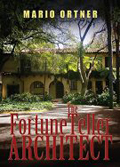
Published Book
In Architect Mateo Gabin’s world, buildings talk. As a child, he is endowed with the ability to hear voices and experience visions from traumatic events in people’s past lives that are recorded in the frames of old houses. But Mateo is not immune to the tragic events in his own life, heading down a path of self-destruction as he struggles with the early loss of his father and a failed first marriage that takes the life of his child.
Continue Reading →
Full Post
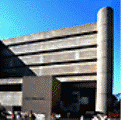
Brutalism (1960 – 1970)
Brutalism was a response to the glass curtain wall that was overtaking institutional and commercial architecture in the 1960s. The style originated in England but quickly expanded to other countries as it afforded an attractive and relatively inexpensive solution to weather and climate control conditions in large buildings, as well as a finish that was less vulnerable to vandalism. The 1960s and 1970s were years of great expansion in universities and public buildings, and this is where the Brutalist style is most often found. The development of béton brut, a concrete with no formal finish, was intrinsically linked to this style. When the formwork is lifted from the poured concrete, the rough, naturally textured surface is the final finish. The amount of texture on the surface is dependent upon the amount of texture on the formwork. The smooth texture of glass for windows and doors forms an attractive contrast. Most windows in Brutalist buildings do not open and the buildings are thoroughly climate- controlled. The design of the building is largely dependent on the shape and placement of the various room masses. Outlines are quite intricate and exterior walkways are emphasized.
Full Post
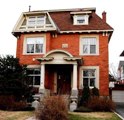
Edwardian Classicism (1900 – 1920)
By 1900, most architecture was reflecting a revival of some sort from pre-Victorian times, (see Period Revivals, Colonial Revival, Classical Revival, Gothic Revival). Like the Georgian and Regency Styles, Edwardian Classicism is associated with the reign of an English monarch. Edward VII, son of Queen Victoria, reigned between 1901 and 1910. The style is a precursor to the simplified styles of the 20th century.
Edwardian Classicism provides simple, balanced designs, straight rooflines, un-complicated ornament, and relatively maintenance-free detailing. These buildings generally have a smooth brick surface and many windows. Many of the Classical features – colonettes, voussoirs, keystones, etc. – are part of this style, but they are applied sparingly and with guarded understatement. Finials and cresting are absent. Cornice brackets and braces are block-like and openings are fitted with flat arches or plain stone lintels.
Full Post
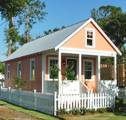
Katrina Cottages (2006 – Present)
Inspired by the need for emergency housing after Hurricane Katrina, this cozy cottage took America by storm.
History:
In 2005, many homes and communities along America’s Gulf Coast were destroyed by Hurricane Katrina and the floods that followed. Architects responded to the crisis by designing low-cost emergency shelters. The Katrina Cottage was a highly popular solution because its simple, traditional design suggested the architecture of a cozy turn-of-the-century house.
The original Katrina Cottage was developed by Marianne Cusato and other leading architects. Cusato’s 308-square foot prototype was later adapted to create a series of about two dozen different versions of the Katrina Cottage designed by a variety of architects and firms.
Katrina Cottages are typically small, ranging from less than 500 square feet up to about 1,000 square feet. A limited number of Katrina Cottage designs are 1,300 square feet and larger. While size and floor plans can vary, Katrina Cottages are prefab houses constructed from factory-made panels. For this reason, Katrina Cottages can be built quickly (often within a few days) and economically. Katrina Cottages are also especially durable. These homes meet the International Building Code and most hurricane codes.
Features:
Usually (not always) one story
Front porch
Turn-of-the century details such as turned columns and brackets
Rot- and termite-resistant siding such as Cementitious Hardiboard
Steel studs
Steel roof
Moisture and mold resistant drywall
Energy-efficient appliances
Full Post
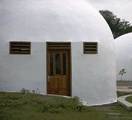
Monolithic Dome (1975 – Present)
Also known as EcoShells, Monolithic Domes can survive tornadoes, hurricanes, earthquakes, fire, and insects.
History:
A Monolithic Dome is a one-peice structure made with concrete and rebar (ridged steel rods). The Monolithic Dome Institute uses the term EcoShells (Economical, Eco-Friendly and Thin-Shell) to describe the monolithic dome structures they developed.
The idea of constructing dome-shaped structures dates back to prehistoric times, but the development of modern concrete and steel Monolithic Domes is credited to designer David B. South. In 1975, he worked with his brothers Barry and Randy to construct a dome-shaped potato storage facility in Shelley, Idaho. Measuring 105 feet round and 35 feet high, the structure is considered the first modern Monolithic Dome. David B. South patented the process and established an enterprise for constructing Monolithic Dome homes, schools, churches, sport stadiums, and commercial buildings.
Advantages:
They use half as much concrete and steel as traditional buildings.
The curved shape of the dome makes it resistant to wind and storm damage.
During earthquakes, they move with the ground instead of collapsing.
They cannot be damaged by fire, rot, or insects.
The thermal mass of the concrete walls makes them energy-efficient.
Features:
A circular concrete slab floor is reinforced with steel rebar.
Vertical steel bars are embedded in the outer edge of the foundation to support the dome.
Blower fans inflate an Airform made of PVC coated nylon or polyester fabrics.
The Airform swells to assume the shape of the structure.
A grid of vertical and horizontal rebar surrounds the exterior of the Airform.
2 or 3 inches of concrete is applied over the rebar grid.
After the concrete is dry, the Airform is removed from the inside. The Airform can be re-used.
Next: Katrina Cottage
Full Post
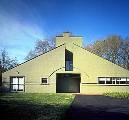
Postmodern (1965 – Present)
Unique, whimsical, and surprising, Postmodern houses give the impression that anything goes. The impossible is not only possible, but exaggerated.
History:
Postmodern (or post-modern) architecture evolved from Modernism, yet it rebels against that style. Modernism is viewed as excessively minimalist, anonymous, monotonous, and boring. Postmodernism has a sense of humor. The style often combines two or more very different elements. A Postmodern house may combine traditional with invented forms or use familiar shapes in surprising, unexpected ways. In other words, postmodern houses often don’t have anything in common with one another, other than their lack of commonality. Postmodern houses may be bizarre, humorous, or shocking, but they are always unique.
Postmodern houses are also sometimes called “Contemporaries,” but a true Contemporary Style house does not incorporate traditional or historical architectural details.
Features:
Forms filled with humor, irony, ambiguity, contradiction
Juxtaposition of styles: Blend of traditional, contemporary, and newly-invented forms
Exaggerated or abstract traditional detailing
Materials or decorations drawn from far away sources
Postmodern Architects; Robert Venturi, Michael Graves, Philip Johnson
Next: Monolithic Dome
Full Post
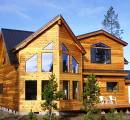
Contemporary (1965 – Present)
Contemporary homes are designed for today’s lifestyles with huge windows and large, open spaces. Some homes have flat roofs. Others have gabled roofs with cathedral ceilings and exposed beams
History:
“Contemporary” describes a catch-all style that can take on many different shapes. A Contemporary home can have the quirkiness of Postmodernism, but it will not express the same kind of irony or humor you find in a Postmodern house. Some Neoeclectic homes are called “Contemporaries,” but a true Contemporary does not use odd mixtures of historic details the way a Neoeclectic house does.
Confused? Your most important clue is the windows: A Contemporary home will always have expansive, very tall panes of glass.
Features:
Odd, irregular shape
Lack of ornamentation
Tall, over-sized windows, some with trapezoid shapes
Open floor plan
Natural materials such as cedar or stone
Harmony with the surrounding landscape
Next: Postmodern (Pomo)
Full Post
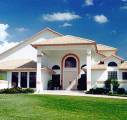
Neo-mediterranean (1965 – Present)
Details from Spain, Italy, and other Mediterranean countries combined with North American ideas to create contemporary Mediterranean or Neo-mediterranean homes.
History:
Neo-mediterranean is a Neoeclectic house style that incoporates a fanciful mix of details suggested by the architecture of Spain, Italy, and Greece, Morocco, and the Spanish Colonies. Realtors often call Neo-mediterrean houses Mediterranean or Spanish.
Neo-mediterranean homes may resemble the much earlier Spanish Revival style. However, they are not careful recreations of Spanish Colonial architecture. If you remove the romantic decorative details, a Neo-mediterranean home is more likely to resemble a no-nonsense, all-American Ranch or Raised Ranch.
Features:
Low-pitched roof
Red roof tiles
Stucco siding
Arches above doors, windows, or porches
Heavy carved wooden doors
Next: Contemporary
Full Post
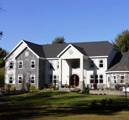
Neoeclectic (1965 – Present)
Recent homes incorporate many styles. Architects and designers call this new stylistic mix Neoeclectic, or Neo-eclectic.
History:
During the late 1960s, a rebellion against modernism and a longing for more traditional styles influenced the design of modest tract housing in North America. Builders began to borrow freely from a variety of historic traditions, offering Neoeclectic (or, Neo-eclectic) houses that were “customized” using a mixture of features selected from construction catalogs. These homes are sometimes called Postmodern because they borrow from a variety of styles without consideration for continuity or context. However, Neoeclectic homes are not usually experimental and do not reflect the artistic vision you would find in a truly original, architect-designed postmodern home.
A Neoeclectic home can be difficult to describe because it combines many styles. The shape of the roof, the design of the windows, and decorative details may be inspired by several different periods and cultures.
Critics use the term McMansion to describe a Neoeclectic home that is over-sized and pretentious. Coined from the McDonald’s fast food restaurant, the name McMansion implies that these homes are hastily assembled using cheaply-made materials and a menu of mix-and-match decorative details.
Features:
Constructed in the 1960s or later
Historic styles imitated using modern materials like vinyl or imitation stone
Details from several historic styles combined
Details from several cultures combined
Brick, stone, vinyl, and composite materials combined
Next: Neo-mediterranean
Full Post

Swiss Miss (1958 – 1960s)
“Swiss Miss” houses combine the charm of a Swiss chalet with the tropical flavor of a Polynesian hut.
History:
Swiss Miss is an informal name given to a variation of the A-Frame house style. Created by draftsman Charles Dubois, a Swiss Miss house resembles a Swiss chalet with tropical, Tiki details.
The Alexander Construction company built fifteen Swiss Miss houses in Palm Springs, California. Other firms built similar homes elsewhere in the United States, but Swiss Miss remained a rare, novelty style, mainly associated with Palm Springs.
Features:
An enormous central gable dominates the front facade
The gable eaves often (but not always) extend almost to the ground
Narrow rectangular posts may be used to support the gable
In some homes, an overlapping second gable may rise above the central gable
An open living area is placed beneath the central gable
Roofs over adjacent rooms may be flat
Post-and-beam construction
Wooden tongue-in-groove or board-and-batten exterior
Stone walls by the main entrance
Stone chimney
Enormous windows
Next: Neoeclectic
Full Post
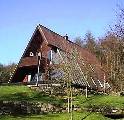
A-frame (1957 – Present)
With a dramatic, sloping roof and cozy living quarters, an A-frame style house is ideal for wintery regions with lots of snow.
History:
Triangular and tee-pee shaped homes date back to the dawn of time, but architect Andrew Geller turned an old idea into a revolutionary concept in 1957 when he built an “A-frame” house in Long Island, New York. Named for the distinctive shape of its roofline, Geller’s design won international attention when it was featured in the New York Times. Soon, thousands of A-frame homes were built around the world.
The steep slope of the A-frame roof is designed to help heavy snow to slide to the ground, instead of remaining on top of the house and weighing it down. At the same time, the sloped roof provides two other benefits. It creates a half floor at the top of the house which can be used for lofts or storage space, and, since the roof extends down to the ground and doesn’t need to painted, it minimizes the amount of exterior maintenance required on the house. On the other hand, the sloped roof creates a triangular “dead space” at the base of the walls on each floor. A-frame houses have limited living space and are usually built as vacation cottages for the mountains or beach.
Features:
Triangular shape
Steeply sloping roof that extends to the ground on two sides
Front and rear gables
Deep-set eaves
1½ or 2½ stories
Many large windows on front and rear façades
Small living space
Few vertical wall surfaces
Next: Swiss Miss Houses
Full Post
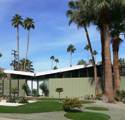
Alexander Houses (1955 – 1965)
Real estate developers Robert and George Alexander captured the spirit of mid-century modernism, building more than 2,500 tract homes in southern California.
History:
During the late 1950s and early 1960s, the George Alexander Construction Company partnered with several architects to develop a unique approach to tract housing. Although the company worked in and near Palm Springs, California, the houses they built were imitated across the United States.
The Alexander Construction Company gave their homes a variety of roof lines and exterior details, making each home seem unique. But, behind their facades, Alexander Homes shared many similarities.
Features:
Post-and-beam construction
Expansive windows
No moldings or trim around windows and doors
Breezeway connecting carport to living quarters
Open floor plans
Three-quarter high wall partitions
Fiberglass or iron screens and walls with decorative cutouts
Idiosyncratic rooflines: Flat, slanted, or butterfly-shaped
Exposed ceiling beams
Exteriors finished with two-tone wood, patterned brick, or decorative concrete block
Next: A-frame style
Full Post

Geodesic Dome (1954 – Present)
Fuller’s invention promised to provide affordable, energy-efficient housing for a troubled planet.
History:
Developed by Buckminster Fuller in 1954, the Geodesic Dome was promoted as the world’s strongest, most economical, lightweight structure. The ingenious engineering of the geodesic dome allows it to cover a wide stretch of space without using internal supports. The geodesic dome design was patented in 1965.
Geodesic Domes are ideal for emergency housing and mobile shelters such as military camps. However, the innovative geodesic shape has been adopted for elegant, upscale housing.
Next: Alexander Houses
Full Post
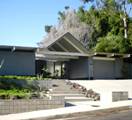
Eichler Houses (1949 – 1974)
An Eichler House is essentially a one-story Ranch, but Eichler’s company reinvented the style, creating a revolutionary new approach to suburban tract housing.
History:
Real estate developer Joseph Eichler brought a fresh, new modernist approach to affordable tract housing. Eichler Homes, constructed about 11,000 houses in California. Many other builders across the United States imitated the design ideas.
In Palm Springs, California, the Alexander Construction Company also pioneered modernist approaches to suburban housing, building thousands of open, sophisticated Alexander Homes.
Features:
Post-and-beam construction
Concrete slab foundation
Long front facade with attached carport
An open-air courtyard at the entrance
Floor-to-ceiling windows
Sliding glass doors
Radiant heat in the floors
Exposed ceiling beams
Next: Geodesic Dome
Full Post
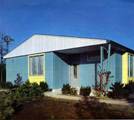
Lustron Homes (1948 – 1950s)
Made of steel coated with porcelain enamel, Lustron Homes were manufactured like cars and transported across the USA.
History:
At the end of World War II, the United States didn’t have enough housing for the 12-million soldiers returning home. President Harry Truman pressured builders and suppliers to construct affordable housing. One of the most promising ventures was the Lustron Home by businessman and inventor Carl Strandlund. Vowing to mass-produce steel houses at the rate of 100 a day, Strandlund landed $37 million in government loans.
The first Lustron house was produced in March 1948. Over the next two years, 2,498 Lustron Homes were manufactured. The steel houses were made like cars on conveyor belts. Flatbed trucks transported the Lustron panels to 36 states, where they were assembled on concrete slabs. Assembly took about two weeks. The completed house cost about $10,000, not including foundations and the lot.
Orders for some 20,000 Lustron Homes poured in, but by 1950 the Lustron Corporation was bankrupt. Today, well-preserved Lustron homes are scarce. Many have been demolished. Others have been altered as homeowners added drywall walls and new exterior siding.
Features:
One-story with a rectangular Ranch Style shape
Roof and walls made of prefabricated steel panels
Panels coated with colored porcelain enamel (the same finish found on bathtubs and appliances)
Four factory-colored finishes: Desert Tan, Dove Gray, Maize Yellow, or Surf Blue
Magnets or glued-on hooks used to hang pictures on metal walls
Concrete slab foundation
Two or three bedrooms
Radiant heating in the ceiling
Built-in bookcase, china cabinet, and overhead cabinets
Combination washing machine / dishwasher
Next: Eichler Houses
Full Post
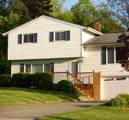
Split-Level Ranch (1945 – 1980s)
In this popular variation of the Ranch house style, a Split-Level Ranch has three or more levels.
History:
A Split-Level Ranch is a Ranch Style house that is divided into several parts. One section is lowered and one section is raised.
Split-level design reflects an approach popularized by American architect Frank Lloyd Wright. Wright believed that houses with “half floors” would blend naturally with the landscape. Living areas could be separated from private areas by just a few steps, rather than a single long staircase.
Features:
The main entrance is usually (although not always) on the center level and opens into the living area. From there, a short flight of stairs leads up to the bedrooms while another short flight of stairs lead down to the garage.
Next: Lustron Homes
Full Post
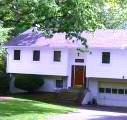
Raised Ranch (1945 – 1980s)
A traditional Ranch Style house is only one story, but a Raised Ranch raises the roof to provide extra living space.
History:
In this variation, the home has two stories. The lower story is at ground level or partially submerged below grade. From the main entrance, a full flight of stairs leads to the main living areas on the upper level.
The Raised Ranch style has been adapted to take on a variety of forms. Neo-Mediterranean, Neo-Colonial, and other contemporary styles are often applied to the simple, practical Raised Ranch shape. Split-level homes may also be described as a variation on the Raised Ranch style. However, a split-level home has three stories or more.
Features:
Two stories
Attached garage
Partially submerged basement with finished rooms and windows
Low-pitched gable roof
Asymmetrical
Large windows: double-hung, sliding, and picture
Sliding glass doors leading to a back yard patio
Little decorative detailing, aside from decorative shutters and porch-roof supports
Variations on the Raised Ranch Style:
Next: Split-Level Ranch Style
Full Post

Ranch Style (1945 – 1980s)
One-story Ranch Style homes are so simple some critics say they have no style. Known as American Ranch, Western Ranch, or California Rambler, Ranch Style houses can be found in nearly every part of the United States.
History:
The earth-hugging Prairie Style houses pioneered by Frank Lloyd Wright and the informal Bungalow styles of the early 20th century paved the way for the popular Ranch Style.
After World War II, real estate developers turned to the simple, economical Ranch Style to meet the housing needs of returning soldiers and their families. The briefly popular Lustron Homes were essentially Ranch houses made of metal. Because so many Ranch houses were built quickly according to a cookie-cutter formula, the Ranch Style later became known as ordinary and, at times, slipshod.
However, during the late 1950s and 1960s, a few real estate developers re-invented the style, giving the conventional one-story Ranch House a modernist flair. Sophisticated Eichler and Alexander Homes were imitated across the United States. setting a new standard for one-story suburban housing.
Features:
Single story
Low pitched gable roof
Deep-set eaves
Horizontal, rambling layout: Long, narrow, and low to the ground
Rectangular, L-shaped, or U-shaped design
Large windows: double-hung, sliding, and picture
Sliding glass doors leading out to patio
Attached garage
Simple floor plans
Emphasis on openness (few interior walls) and efficient use of space
Built from natural materials: Oak floors, wood or brick exterior
Lack decorative detailing, aside from decorative shutters
Next: Raised Ranch Style
Full Post
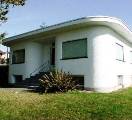
Art Moderne (1930s – 1950s)
With the sleek appearance of a modern machine, Art Moderne – or, Streamline Moderne – houses expressed the spirit of a technological age.
History:
The sleek Art Moderne style originated in the Bauhaus movement, which began in Germany. Bauhaus architects wanted to use the principles of classical architecture in their purest form, designing simple, useful structures without ornamentation or excess. Building shapes were based on curves, triangles, and cones. Bauhaus ideas spread worldwide and led to the International Style in the United States. Modern art, architecture, and fashion became popular just as the Art Deco style was falling out of favor. Many products produced during the 1930s, from architecture to jewelry to kitchen appliances, expressed the new Art Moderne ideals.
Art Moderne houses were also practical because these simple dwellings were so easy and economical to build. However, the Art Moderne or Streamline Moderne style was also favored for chic homes of the very wealthy.
Features:
Asymmetrical
Low, horizontal shape
Flat roof
No cornices or eaves
Smooth, white walls
Streamlined appearance
Rounded corners
Glass block windows and wraparound windows
Windows in horizontal rows
Porthole windows and other nautical details
Aluminum and steel window and door trim
Mirrored panels
Steel balustrades
Open floor plans
Next: Ranch style
Full Post
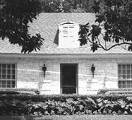
French Eclectic (1915 – 1945)
French Eclectic homes combine a variety of influences from the architecture of France.
History:
After World War I, soldiers returning to the United States and Canada brought a keen interest in French housing styles. Building plan books and home magazines began to feature modest homes inspired by French building traditions. Grand homes were constructed with a fanciful mix of French details.
French Normandy House Style: Borrows ideas from Normandy, where barns were attached to the living quarters. Grain or ensilage was stored in a central turret. The Norman Cottage is a cozy and romantic style that features a small round tower topped by a cone-shaped roof. Other Normandy homes resemble miniature castles with arched doorways set in imposing towers.
French Provincial House Style: Tends to be square and symmetrical. They resemble small manor homes with massive hipped roofs and window shutters. Frequently, tall second floor windows break through the cornice. French Provincial homes do not have towers.
Features:
Brick, stone, or stucco siding
Hipped roof
Flared eaves
Dormers
Multi-paned windows
Some French style homes also have:
Decorative half-timbering
Round tower at entryway
Arched doorway
Next: Art Moderne
Full Post
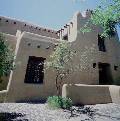
Pueblo Revival (1912 – Present)
Because they are built with adobe, Pueblo homes are sometimes called Adobes. Modern Pueblos are inspired by homes used by Native Americans since ancient times.
History:
Since ancient times, Pueblo Indians built large, multi-family houses, which the Spanish called pueblos (villages). In the 17th and 18th centuries, the Spanish made their own Pueblo homes, but they adapted the style. They formed the adobe into sun-dried building blocks. After stacking the blocks, the Spaniards covered them with protective layers of mud.
Pueblo Revival houses became popular in the early 1900s, mainly in California and the southwestern United States. During the 1920s, aviation pioneer Glenn Curtiss and his partner James Bright introduced their own version of Pueblo Revival architecture to Florida. In the region that is now Miami Springs, Curtiss and Bright built an entire development of thick-walled buildings made of wood frame or concrete block.
Modern day Pueblo homes are often made with concrete blocks or other materials covered with adobe, stucco, plaster, or mortar.
Features:
Massive, round-edged walls made with adobe
Flat roof with no overhang
Stepped levels
Rounded parapet
Spouts in the parapet to direct rainwater
Vigas (heavy timbers) extending through walls to support the roof
Latillas (poles) placed above vigas in angled pattern
Deep window and door openings
Simple windows
Beehive corner fireplace
Bancos (benches) that protrude from walls
Nichos (niches) carved out of wall for display of religious icons
Brick, wood, or flagstone floors
Due to Spanish influence, Pueblo Revival homes may also have these features:
Porches held up with zapatas (posts)
Enclosed patios
Heavy wooden doors
Elaborate corbels
Variations of the Pueblo Revival style:
Pueblo Deco. Combining Pueblo Revival with Art Deco architecture.
Santa Fe Style. This type of Pueblo became the standard in New Mexico.
Contemporary Pueblo. Stripped down, unornamented Pueblos without posts, beams, or vigas.
Territorial Pueblo. Corners are square instead of rounded. Windows are framed with straight wooden moldings.
Next: French Eclectic
Full Post
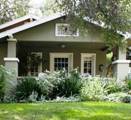
Bungalow (1905 – 1930s)
California Bungalows, Craftsman Bungalows, and Chicago Bungalows were variations of an affordable housing type that swept across America.
History:
The Bungalow is an all American housing type, but it has its roots in India. In the province of Bengal, single-family homes were called bangla or bangala. British colonists adapted these one-story thatch-roofed huts to use as summer homes. The space-efficient floor plan of bungalow houses may have also been inspired by army tents and rural English cottages. The idea was to cluster the kitchen, dining area, bedrooms, and bathroom around a central living area.
The first American house to be called a bungalow was designed in 1879 by William Gibbons Preston. Built at Monument Beach on Cape Cod, Massachusetts, the two-story house had the informal air of resort architecture. However, this house was much larger and more elaborate than the homes we think of when we use the term Bungalow.
Bungalow houses may reflect different architectural styles, such as Craftsman Bungalow, California Bungalow, Spanish Colonial Revival Bungalow, Dutch Colonial Revival Bungalow, etc.
Features:
One and a half stories
Most of the living spaces on the ground floor
Low-pitched roof and horizontal shape
Living room at the center
Connecting rooms without hallways
Efficient floor plan
Built-in cabinets, shelves, and seats
Next: Pueblo revival
Full Post

Arts and Crafts (1905 – 1930s)
From cozy bungalows to sprawling Prairie houses, many American homes were shaped by Craftsman ideas.
History:
During the 1880s, John Ruskin, William Morris, Philip Webb, and other English designers and thinkers launched the Arts and Crafts Movement, which celebrated handicrafts and encouraged the use of simple forms and natural materials. In the United States, two California brothers, Charles Sumner Greene and Henry Mather Green, began to design houses that combined Arts and Crafts ideas with a fascination for the simple wooden architecture of China and Japan.
The name “Craftsman” comes from the title of a popular magazine published by the famous furniture designer, Gustav Stickley, between 1901 and 1916. A true Craftsman house is one that is built according to plans published in Stickley’s magazine. But other magazines, pattern books, and mail order house catalogs began to publish plans for houses with Craftsman-like details. Soon the word “Craftsman” came to mean any house that expressed Arts and Crafts ideals, most especially the simple, economical, and extremely popular Bungalow.
A Craftsman house is often a Bungalow, but many other styles can have Arts and Crafts, or Craftsman features.
Features:
Wood, stone, or stucco siding
Low-pitched roof
Wide eaves with triangular brackets
Exposed roof rafters
Porch with thick square or round columns
Stone porch supports
Exterior chimney made with stone
Open floor plans; few hallways
Numerous windows
Some windows with stained or leaded glass
Beamed ceilings
Dark wood wainscoting and moldings
Built-in cabinets, shelves, and seating
Next: Bungalow
Full Post
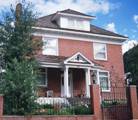
American Foursquare (1895 – 1930s)
The Foursquare style, sometimes called the Prairie Box, can be found in nearly every part of the United States.
History:
The American Foursquare, or the Prairie Box, was a post-Victorian style that shared many features with the Prairie architecture pioneered by Frank Lloyd Wright. The boxy foursquare shape provided roomy interiors for homes on small city lots. The simple, square shape also made the Foursquare style especially practical for mail order house kits from Sears and other catalog companies.
Creative builders often dressed up the basic foursquare form. Although foursquare houses are always the same square shape, they can have features borrowed from any of these styles:
Queen Anne – bay windows, small towers, or “gingerbread” trim
Mission – stucco siding and roof parapets
Colonial Revival – pediments or porticos
Craftsman – exposed roof rafters, beamed ceilings, built-in cabinetry, and carefully crafted woodwork
Features:
Simple box shape
Two-and-a-half stories high
Four-room floor plan
Low-hipped roof with deep overhang
Large central dormer
Full-width porch with wide stairs
Brick, stone, stucco, concrete block, or wood siding
Next: Arts and Crafts (Craftsman)
Full Post
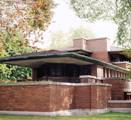
Prairie Style (1893s – 1920s)
Frank Lloyd Wright revolutionized the American home when he began to design “Prairie” style houses with low horizontal lines and open interior spaces.
History:
Frank Lloyd Wright believed that rooms in Victorian era homes were boxed-in and confining. He began to design houses with low horizontal lines and open interior spaces. Rooms were often divided by leaded glass panels. Furniture was either built-in or specially designed. These homes were called prairie style after Wright’s 1901 Ladies Home Journal plan titled, “A Home in a Prairie Town.” Prairie houses were designed to blend in with the flat, prairie landscape.
The first Prairie houses were usually plaster with wood trim or sided with horizontal board and batten. Later Prairie homes used concrete block. Prairie homes can have many shapes: Square, L-shaped, T-shaped, Y-shaped, and even pinwheel-shaped.
In 1936, during the USA depression, Frank Lloyd Wright developed a simplified version of Prairie architecture called Usonian. Wright believed these stripped-down houses represented the democratic ideals of the United States.
The popular American Foursquare style, sometimes called the Prairie Box, shared many features with the Prairie style.
Features:
Low-pitched roof
Overhanging eaves
Horizontal lines
Central chimney
Open floor plan
Clerestory windows
Next: American Foursquare
Full Post
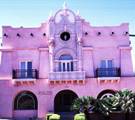
Mission Revival (1890s – 1920s)
Historic mission churches built by Spanish colonists inspired the turn-of-the-century house style known as Mission, Spanish Mission, or California Mission.
History:
Celebrating the architecture of Hispanic settlers, Mission Revival style houses usually have arched dormers and roof parapets. Some resemble old Spanish mission churches with bell towers and elaborate arches.
The earliest Mission style homes were built in California, USA. The style spread eastward, but most Spanish Mission homes are located in the southwestern states. Deeply shaded porches and dark interiors make these homes particularly suited for warmer climates.
Mission houses often have details from the Prairie, Pueblo and Arts & Crafts styles.
Features:
Smooth stucco siding
Roof parapets
Large square pillars
Twisted columns
Arcaded entry porch
Round or quatrefoil window
Red tile roof
Next: Prairie Style
Full Post
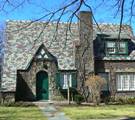
Cotswold Cottage (1890s – 1940s)
With roots in the pastoral Cotswold region of England, the picturesque Cotswold Cottage style may remind you of a cozy storybook house.
Other names for the Cotswold Cottage style: Storybook Style, Hansel and Gretel Cottage, Tudor Cottage, English Country Cottage, Ann Hathaway Cottage.
History:
The small, fanciful Cotswold Cottage is a popular subtype of the Tudor Revival house style. This quaint English country style is based on the cottages built since medieval times in the Cotswold region of southwestern England. A fascination for medieval styles inspired American architects create modern versions of the rustic homes. The Cotswold Cottage style became especially popular in the United States during the 1920s and 1930s.
The picturesque Cotswold Cottage is usually asymmetrical with a steep, complex roof line. The floor plan tends to include small, irregularly-shaped rooms, and the upper rooms have sloping walls with dormers. The home may have a sloping slate or cedar roof that mimics the look of thatch. A massive chimney often dominates either the front or one side of the house.
Features:
Sloping, uneven roof, sometimes made of pseudo-thatch
Brick, stone, or stucco siding
Very steep cross gables
Prominent brick or stone chimney, often at the front near the door
Casement windows with small panes
Small dormer windows
Asymmetrical design
Low doors and arched doors
Small, irregularly-shaped rooms
Sloping walls in rooms on upper floor
Next: Mission Revival House Style
Full Post
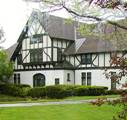
Tudor Revival (1890s – Present)
Heavy chimneys and decorative half-timbering give Tudor style houses a Medieval flavor. The Tudor style is sometimes called Medieval Revival.
History:
The name Tudor suggests that these houses were built in the 1500s, during the Tudor Dynasty in England. But of course, Tudor houses in the United States are modern-day re-inventions and are more accurately called Tudor Revival or Medieval Revival. Some Tudor Revival houses mimic humble Medieval cottages – They may even include a false thatched roof. Other Tudor Revival homes suggest Medieval palaces. They may have overlapping gables, parapets, and beautifully patterned brick or stonework. These historic details combine with Victorian or Craftsman flourishes.
As in many Queen Anne and Stick style homes, Tudor style houses often feature striking decorative timbers. These timbers hint at – but do not reproduce – Medieval construction techniques. In Medieval houses, the timber framing was integral with the structure. Tudor Revival houses, however, merely suggest the structural framework with false half-timbering. This decorative woodwork comes in many different designs, with stucco or patterned brick between the timbers.
In the United States, Tudor styling takes on a variety of forms ranging from elaborate mansions to modest suburban homes with mock masonry veneers. The style became enormously popular in the 1920s and 1930s, and modified versions became fashionable in the 1970s and 1980s.
One popular housing type inspired by inspired by Tudor ideas is the Cotswold Cottage. These quaint homes have an imitation thatched roof, massive chimneys, an uneven sloping roof, small window panes, and low doors.
Features:
Decorative half-timbering
Steeply pitched roof
Prominent cross gables
Tall, narrow windows
Small window panes
Massive chimneys
Next: Cotswold Cottage
Full Post
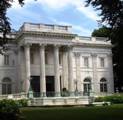
Beaux Arts (1885s – 1925s)
Combining classical Greek and Roman architecture with Renaissance ideas, Beaux Arts was a favored style for grand public buildings and opulent mansions.
History:
The Beaux Arts (French for “fine art”) style originated in the École des Beaux Arts in Paris. Many American architects studied at this legendary architectural school, where they learned about the aesthetic principles of classical design and brought them to the United States.
Also known as Beaux Arts Classicism, Academic Classicism, or Classical Revival, Beaux Arts is a late and eclectic form of Neoclassicism. It combines classical architecture from ancient Greece and Rome with Renaissance ideas. Beaux Arts is characterized by order, symmetry, formal design, grandiosity, and elaborate ornamentation. In the United States, the Beaux Arts style led to planned neighborhoods with large, showy houses, wide boulevards, and vast parks. Due to the size and grandiosity of the buildings, the Beaux Arts style is most commonly used for public buildings like museums, libraries, banks, courthouses, and government buildings.
The popularity of the Beaux Arts style waned in the 1920’s, and within 25 years the buildings were considered ostentatious. Later in the 20th century, postmodernists rediscovered an appreciation of the Beaux Arts ideals.
Features:
Massive and grandiose – Constructed with stone
Balustrades
Balconies
Columns
Cornices
Pilasters
Triangular pediments
Lavish decorations: swags, medallions, flowers, and shields
Grand stairway
Large arches
Symmetrical façade
Next: Tudor Revival
Full Post
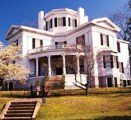
Neoclassical (1885s – 1925s)
Neoclassical, or “new” classical, architecture describes buildings that are inspired by the classical architecture of ancient Greece and Rome.
History:
The word Neoclassical is often used to describe an architectural style, but Neoclassicism is not actually any one distinct style. Neoclassicism is a trend, or approach to design, that can describe several very different styles.
Similar styles:
Federal, Greek Revival, Georgian, Antebellum houses, Beaux Arts.
Next: Beaux Arts
Full Post
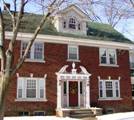
Colonial Revival (1876s – 1955s)
Expressing American patriotism and a return to classical architectural styles, Colonial Revival became a standard style in the 20th century.
History:
Colonial Revival became a popular American house style after it appeared at the 1876 the US Centennial Exposition. Reflecting American patriotism and a desire for simplicity, the Colonial Revival house style remained popular until the mid-1950’s. Between World War I and II, Colonial Revival was the most popular historic revival house style in the United States.
Some architectural historians say that Colonial Revival is a Victorian style; others believe that the Colonial Revival style marked the end of the Victorian period in architecture. The Colonial Revival style is based loosely on Federal and Georgian house styles, and a clear reaction against excessively elaborate Victorian Queen Anne architecture. Eventually, the simple, symmetrical Colonial Revival style became incorporated into the Foursquare and Bungalow house styles of the early 20th century.
Subtypes of the Colonial Revival House Style are:
Dutch Colonial: Two-story house made of clapboard or shingles with a gambrel roof, flared eaves, and a side-entry floor plan.
Garrison Colonial: The second story protrudes; the first story is slightly recessed.
Saltbox Colonial: Like the original saltbox homes from colonial times, a Saltbox Style Colonial Revival has two stories at the front and one story at the rear. The gable roof covers both levels, sloping sharply down in the rear.
Spanish Colonial Revival: Low-pitched ceramic tile roof, stucco walls, eaves with little or no overhang, wrought iron, and windows and doorways with round arches.
Features:
Symmetrical façade
Rectangular
2 to 3 stories
Brick or wood siding
Simple, classical detailing
Gable roof
Pillars and columns
Multi-pane, double-hung windows with shutters
Dormers
Temple-like entrance: porticos topped by pediment
Paneled doors with sidelights and topped with rectangular transoms or fanlights
Center entry-hall floor plan
Living areas on the first floor and bedrooms on the upper floors
Fireplaces
Next: Neoclassical
Full Post
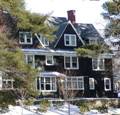
Shingle Style (1874 – 1910s)
Rustic Shingle Style houses shunned Victorian fussiness.
History:
Shingle Style houses can take on many forms. Some have tall turrets, suggestive of Queen Anne architecture. Some have gambrel roofs, Palladian windows, and other Colonial Revival details. Some Shingle houses have features borrowed from Tudor, Gothic and Stick styles. But, unlike those styles, Shingle architecture is relaxed and informal. Shingle houses do not have the lavish decorations that were popular during the Victorian era.
The term “Shingle Style” was coined because these homes are usually sided in rustic cedar shingles. However, not all Shingle Style houses are shingle-sided. You will recognize them by their complicated shapes and rambling, informal floor plans.
Features:
Continuous wood shingles on siding and roof
Irregular roof line
Cross gables
Eaves on several levels
Porches
Asymmetrical floor plan
Some Shingle Style homes also have these features:
Wavy wall surface
Patterned shingles
Squat half-towers
Palladian windows
Rough hewn stone on lower stories
Stone arches over windows and porches
Next: Colonial Revival
Full Post

Richardsonian Romanesque (1880s – 1900s)
Richardsonian Romanesque, or Romanesque Revival, houses have broad Roman arches and massive stone walls.
History:
During the 1870s, Boston architect Henry Hobson Richardson captured the American imagination with rugged, forceful buildings like Allegheny Courthouse in Pittsburgh and Trinity Church in Boston. These buildings were called “Romanesque” because they had wide, rounded arches like buildings in ancient Rome. Henry Hobson Richardson became so famous for his Romanesque designs that the style is often called Richardsonian Romanesque.
The heavy Romanesque style was especially suited for grand public buildings. However, Romanesque buildings, with massive stone walls, were expensive to construct. Only the wealthy adopted the Richardsonian Romanesque style for private homes.
Features:
Constructed of rough-faced, square stones
Round towers with cone-shaped roofs
Columns and pilasters with spirals and leaf designs
Low, broad “Roman” arches over arcades and doorways
Patterned masonry arches over windows
Next: Shingle Style
Full Post
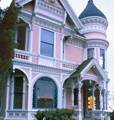
Eastlake Victorian (1860s – 1880s)
Fanciful Victorian houses lavished with Eastlake style spindlework.
History:
A colorful Victorian style with lacy, ornamental details is called Eastlake. The ornamental style is named after the famous English designer, Charles Eastlake, who was famous for making furniture decorated with fancy spindles.
Features:
Eastlake details can be found on a variety of Victorian house styles. Some of the more fanciful Stick Style Victorians have Eastlake buttons and knobs combined with the angular stick work.
Next: Richardsonian Romanesque
Full Post
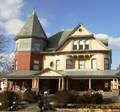
Queen Anne (1880s – 1910s)
America’s fanciful Queen Anne architecture takes on many shapes.
History:
The romantic style known as Queen Anne became an architectural fashion in the USA during the 1880s and 1890s, when the industrial revolution brought new technologies. Builders began to use mass-produced pre-cut architectural trim to create fanciful and sometimes flamboyant houses.
Not all Queen Anne houses are lavishly decorated, however. Some builders showed restraint in their use of embellishments. Still, the flashy “painted ladies” of San Francisco and the refined brownstones of Brooklyn share many of the same features.
Queen Anne architecture in the USA is very different from the slightly earlier English versions of the style. Moreover, in both the USA and England, Victorian Queen Anne architecture has little do with the British queen who ruled during the 1700s.
Features:
Steep roof
Complicated, asymmetrical shape
Front-facing gable
One-story porch that extends across one or two sides of the house
Round or square towers
Wall surfaces textured with decorative shingles, patterned masonry, or half-timbering
Ornamental spindles and brackets
Bay windows
Next: Eastlake Victorian
Full Post
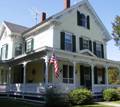
Folk Victorian (1870s – 1910s)
Plain folk could afford these simple North American homes.
History:
Life was simple before the age of railroads. In the vast, remote stretches of North America, families built no-fuss, square or L-shaped houses in the National or Folk style. But the rise of industrialization made it easier and more affordable to add decorative details to otherwise simple homes. Decorative architectural trim could be mass produced. As the railroads expanded, factory-made building parts could be sent to far corners of the continent.
Many Folk Victorian houses were adorned with flat, jigsaw cut trim in a variety of patterns. Others had spindles, gingerbread and details borrowed from the Carpenter Gothic style. With their spindles and porches, some Folk Victorian homes may suggest Queen Anne architecture. But unlike Queen Anne’s, Folk Victorian houses are orderly and symmetrical houses. They do not have towers, bay windows, or elaborate moldings.
Features:
Square, symmetrical shape
Brackets under the eaves
Porches with spindlework or flat, jigsaw cut trim
Some Folk Victorian homes have:
Carpenter Gothic details
Low-pitched, pyramid shaped roof
Front gable and side wings
Next: Queen Anne
Full Post
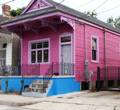
Shotgun (1860s – 1930s)
Long and narrow, shotgun houses are made to fit small city building lots.
History
Shotgun houses have been built since the time of the Civil War. The economical style became popular in many southern towns, especially New Orleans.
There are a few theories why these houses were called Shotgun:
If you fire a shotgun through the front door, the bullets will fly straight out through the back door.
Some shotgun houses were constructed from packing crates that once held shotgun shells.
The word shotgun might come from to-gun, which means place of assembly in an African dialect.
Features:
The entire house is no wider than 12 feet (3.5 meters)
Rooms are arranged in a single row, without hallways
The living room is at the front, with bedrooms and kitchen behind
The house has two doors, one at the front and one at the rear
A long pitched roof provides natural ventilation
The house may rest on stilts to prevent flood damage
Next: Folk Victorian
Full Post
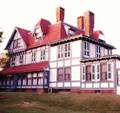
Stick Style (1860s – 1890s)
Stick Style Victorian houses have exposed trusses, “stickwork,” and other details borrowed from medieval times.
History:
The most important features of Stick Style houses are on the exterior wall surfaces, which are ornamented with “stickwork,” or decorative half-timbering. The house also has brackets, rafters, and braces. These details are not necessary structurally. They are decorations that imitated architecture from the medieval past. Instead of three-dimensional ornamentation, the emphasis is on patterns and lines. Because the decorative details are flat, they are often lost when homeowners remodel. If the decorative stickwork is covered up with vinyl siding or painted a single solid color, a Stick Style Victorian may appear plain and rather ordinary.
The Palliser Company, which published many plan books during the Victorian era, called stick architecture plain yet neat, modern, and comfortable. However, Stick was a short-lived fashion. The angular and austere style couldn’t compete with the fancy Queen Annes that took America by storm. Some Stick architecture did dress up in fancy Eastlake spindles and Queen Anne flourishes. But very few authentic Stick Style homes remain intact.
On first glance, you might confuse Stick houses with the later Tudor Revival Style. However, most Tudor Revival houses are sided with stucco, stone, or brick. Stick Style houses are almost always made with wood.
Features:
Rectangular shape
Wood siding
Steep, gabled roof
Overhanging eaves
Ornamental trusses (gable braces)
Decorative braces and brackets
Decorative half-timbering
Next: Shotgun Style
Full Post
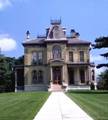
Second Empire (1855 – 1885)
With tall mansard roofs and wrought iron cresting, Second Empire homes create a sense of height.
History:
Second Empire buildings with tall mansard roofs were modeled after the the opulent architecture of Paris during the reign of Napoleon III. French architects used the term horror vacui – the fear of unadorned surfaces – to describe the highly ornamented Second Empire style. Second Empire buildings were also practical: their height allowed for additional living space on narrow city lots.
In the United States, government buildings in the Second Empire style resemble the elaborate French designs. Private homes, however, often have an Italianate flavor. Both Italianate and Second Empire houses tend to be square in shape, and both can have U-shaped window crowns, decorative brackets, and single story porches. But, Italianate houses have much wider eaves… and they do not have the distinctive mansard roof characteristic of the Second Empire style.
Features:
Mansard roof
Dormer windows project like eyebrows from roof
Rounded cornices at top and base of roof
Brackets beneath the eaves, balconies, and bay windows
Many Second Empire homes also have these features:
Cupola
Patterned slate on roof
Wrought iron cresting above upper cornice
Classical pediments
Paired columns
Tall windows on first story
Small entry porch
Next: Stick Style
Full Post
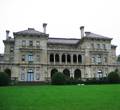
Renaissance Revival (1840s – 1915)
A fascination for the architecture of Renaissance Europe and the villas of Andrea Palladio inspired elegant Renaissance Revival homes.
History:
Renaissance (French for “rebirth”) refers to the artistic, architectural, and literary movement in Europe between the 14th and 16th centuries. The Renaissance Revival style is based on the architecture of 16th-century Renaissance Italy and France, with additional elements borrowed from Ancient Greek and Roman architecture. Renaissance Revival is a general term which encompasses the various Italian Renaissance Revival and French Renaissance Revival styles, including Second Empire.
The Renaissance Revival style was popular during two separate phases. The first phase, or the First Renaissance Revival, was from about 1840 to 1885, and the Second Renaissance Revival, which was characterized by larger and more elaborately decorated buildings, was from 1890 to 1915. Due to the expensive materials required and the elaborate style, Renaissance Revival was best suited for public and commercial buildings, and very grand homes for the wealthy.
Features:
Cube-shaped
Balanced, symmetrical façade
Smooth stone walls, made from finely-cut ashlar, or smooth stucco finish
Low-pitched hip or Mansard roof
Roof topped with balustrade
Wide eaves with large brackets
Horizontal stone banding between floors
Segmental pediments
Ornately-carved stone window trim varying in design at each story
Smaller square windows on top floor
Quoins (large stone blocks at the corners)
“Second” Renaissance Revival Houses are larger and usually feature:
Arched, recessed openings
Full entablatures between floors
Columns
Ground floor made of rusticated stone with beveled edges and deeply-recessed joints
About the Renaissance Revival Style
Next: Second Empire Style
Full Post

Italianate (1840s – 1885)
Italianate became the most popular housing style in Victorian America. Italianate is also known as the Tuscan, the Lombard, or simply, the bracketed style.
History:
The Italianate style began in England with the picturesque movement of the 1840s. For the previous 200 years, English homes tended to be formal and classical in style. With the picturesque, movement, however, builders began to design fanciful recreations of Italian Renaissance villas. When the Italianate style moved to the United States, it was reinterpreted again to create a uniquely American style.
By the late 1860s, Italianate was the most popular house style in the United States. Historians say that Italianate became the favored style because the homes could be constructed with many different building materials, and the style could be adapted to modest budgets. In addition, new technologies of the Victorian era made it possible to quickly and affordably produce cast-iron and press-metal decorations.
Italianate remained the most popular house style in the USA until the 1870s. Italianate was also a common style for barns, town halls, and libraries. You will find Italianate buildings in nearly every part of the United States except for the deep South. There are fewer Italianate buildings in the southern states because the style reached its peak during the Civil War, a time when the south was economically devastated. After the 1870s, architectural fashion turned toward late Victorian styles such as Queen Anne.
Features:
Low-pitched or flat roof
Balanced, symmetrical rectangular shape
Tall appearance, with 2, 3, or 4 stories
Wide, overhanging eaves with brackets and cornices
Square cupola
Porch topped with balustraded balconies
Tall, narrow, double-paned windows with hood moldings
Side bay window
Heavily molded double doors
Roman or segmented arches above windows and doors
Next: Renaissance Revival Style
Full Post
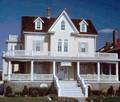
Gothic Revival – Wood (1840s – 1880s)
Builders borrowed church-like details to construct affordable wooden versions of the Gothic Revival style.
History:
The earliest Gothic Revival homes were constructed of stone and brick. The Gothic Revival style imitated the great cathedrals and castles of Europe. However, few people could afford to build grand masonry homes in the Gothic Revival style. In the United States, The ready availability of lumber and factory-made architectural trim lead to a distinctly American version of Gothic Revival. Wood-framed Gothic Revival homes became America’s dominant style in the mid-1800s.
New machines invented during the Victorian era made it easy and affordable to add scrolled ornaments, lacy bargeboards, “gingerbread” trim, and other decorative details. Heavily decorated wood-frame cottages in the Gothic Revival style are often called Carpenter Gothic.
Features:
Steeply pitched roof
Steep cross gables
Windows with pointed arches
Vertical board and batten siding
One-story porch
Next: Italianate style
Full Post

Gothic Revival – Masonry (1840s – 1880s)
Medieval cathedrals inspired impressive homes made of stone.
History:
Gothic Revival was a Victorian style that borrowed details from Gothic cathedrals and other medieval architecture. Gothic Revival homes in England were most frequently constructed of masonry. In the United States, some large, lavish estates were also made with stone or brick. These homes often resembled medieval churches or castles.
Few people could afford to build a masonry home in the Gothic Revival or High Gothic revival style. In the United States, the masonry versions of Gothic Revival and High Gothic Revival architecture were used mainly for churches, public buildings, and grand estates. However, the ready availability of lumber lead to a distinctly American version of the Gothic Revival style, constructed with wood.
Features:
Pointed windows with decorative tracery
Grouped chimneys
Pinnacles
Flat roofs with Battlements, or gable roofs with parapets
Leaded glass
Quatrefoil and clover shaped windows
Oriel windows
In the 1870s, a related style, High Victorian Gothic or Neo-Gothic, grew out of the Gothic Revival movement.
Features of the High Victorian Gothic style:
Strong vertical lines and a sense of great height
Heavy, bold details
Leaves, vines, gargoyles, and other stone carvings
Multi-colored masonry, often forming patterns or bands
Slightly pointed Romanesque arches
Faithful re-creation of medieval styles
Next: Gothic Revival – Wood
Full Post
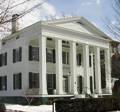
Greek Revival (1825 – 1860s)
With details reminiscent of the Parthenon, stately, pillared Greek Revival homes reflect a passion for antiquity.
History:
In the mid-19th century, many prosperous Americans believed that ancient Greece represented the spirit of democracy. Interest in British styles had waned during the bitter War of 1812. Also, many Americans sympathized with Greece’s own struggles for independence in the 1820s.
Greek Revival architecture began with public buildings in Philadelphia. Many European-trained architects designed in the popular Grecian style, and the fashion spread via carpenter’s guides and pattern books. Colonnaded Greek Revival mansions – sometimes called Southern Colonial houses – sprang up throughout the American south. With its classic clapboard exterior and bold, simple lines, Greek Revival architecture became the most predominant housing style in the United States.
During the second half of the 19th century, Gothic Revival and Italianate styles captured the American imagination. Grecian ideas faded from popularity. However, front-gable design – a trademark of the Greek Revival style – continued to influence the shape of American houses well into the 20th century. You will notice the classic front-gable design in simple “National Style” farm houses throughout the United States.
Features:
Pedimented gable
Symmetrical shape
Heavy cornice
Wide, plain frieze
Bold, simple moldings
Many Greek Revival houses also have these features:
Entry porch with columns
Decorative pilasters
Narrow windows around front door
Next: Gothic Revival Style
Full Post
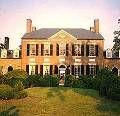
Federal and Adam (1780s – 1840s)
Graceful details distinguish Federal homes from the pragmatic Georgian colonial style.
History:
Like much of America’s architecture, the Federal (or Federalist) style has its roots in the British Isles. Two Scottish brothers named Adam adapted the pragmatic Georgian style, adding swags, garlands, urns, and other delicate details. In the American colonies, homes and public buildings also took on graceful airs. Inspired by the work of the Adam brothers and also by the great temples of ancient Greece and Rome, Americans began to build homes with Palladian windows, circular or elliptical windows, recessed wall arches, and oval-shaped rooms. This new Federal style became associated with America’s evolving national identity.
It’s easy to confuse Federalist architecture with the earlier Georgian Colonial style. The difference is in the details: While Georgian homes are square and angular, a Federal style building is more likely to have curved lines and decorative flourishes. Federalist architecture was the favored style in the United States from about 1780 until the 1830s. However, Federalist details are often incorporated into modern American homes.
Features:
Low-pitched roof, or flat roof with a balustrade
Windows arranged symmetrically around a center doorway
Semicircular fanlight over the front door
Narrow side windows flanking the front door
Decorative crown or roof over front door
Tooth-like dentil moldings in the cornice
Palladian window
Circular or elliptical windows
Shutters
Decorative swags and garlands
Oval rooms and arches
Next: Greek Revival Style
Full Post

Georgian Colonial (1690s – 1830s)
Spacious and comfortable, Georgian Colonial architecture reflected the rising ambition of a new country.
History
Georgian Colonial became the rave in New England and the Southern colonies during the 1700’s. Stately and symmetrical, these homes imitated the larger, more elaborate Georgian homes which were being built in England. But the origin of the style goes back much farther. During the reign of King George I in the early 1700’s, and King George III later in the century, Britons drew inspiration from the Italian Renaissance and from ancient Greece and Rome. Georgian ideals came to New England via pattern books, and Georgian styling became a favorite of well-to-do colonists. More humble dwellings also took on characteristics of the Georgian style. America’s Georgian homes tend to be less ornate than those found in Britain.
Features
Square, symmetrical shape
Paneled front door at center
Decorative crown over front door
Flattened columns on each side of door
Five windows across front
Paired chimneys
Medium pitched roof
Minimal roof overhang
Many Georgian Colonial homes also have:
Nine or twelve small window panes in each window sash
Dentil molding (square, tooth-like cuts) along the eaves
Next: Federal and Adam Styles
Full Post
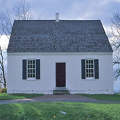
Cape Cod (1600s – 1950s)
The Cape Cod style originated in colonial New England. Today, the term refers to Cape Cod-shaped houses popular during the 1930s, 1940s, and 1950s.
History:
The first Cape Cod style homes were built by English colonists who came to America in the late 17th century. They modeled their homes after the half-timbered houses of England, but adapted the style to the stormy New England weather. Over the course of a few generations, a modest, one- to one-and-a-half-story house with wooden shutters emerged.
In the late 1800s and early 1900s, a renewed interest in America’s past inspired a variety of Colonial Revival styles. Colonial Revival Cape Cod houses became especially popular during the 1930s. These small, economical houses were mass-produced in suburban developments across the United States.
Features:
Steep roof with side gables
Small roof overhang
1 or 1½ stories
Made of wood and covered in wide clapboard or shingles
Large central chimney linked to fireplace in each room
Symmetrical appearance with door in center
Dormers for space, light, and ventilation
Multi-paned, double-hung windows
Shutters
Formal, center-hall floor plan
Hardwood floors
Little exterior ornamentation
Twentieth century Cape Cod houses often have dormers. The chimney is usually placed at one end instead of at the center. Shutters on modern Cape Cod houses are strictly decorative and can’t be closed during a storm.
Next: Georgian Colonial Style